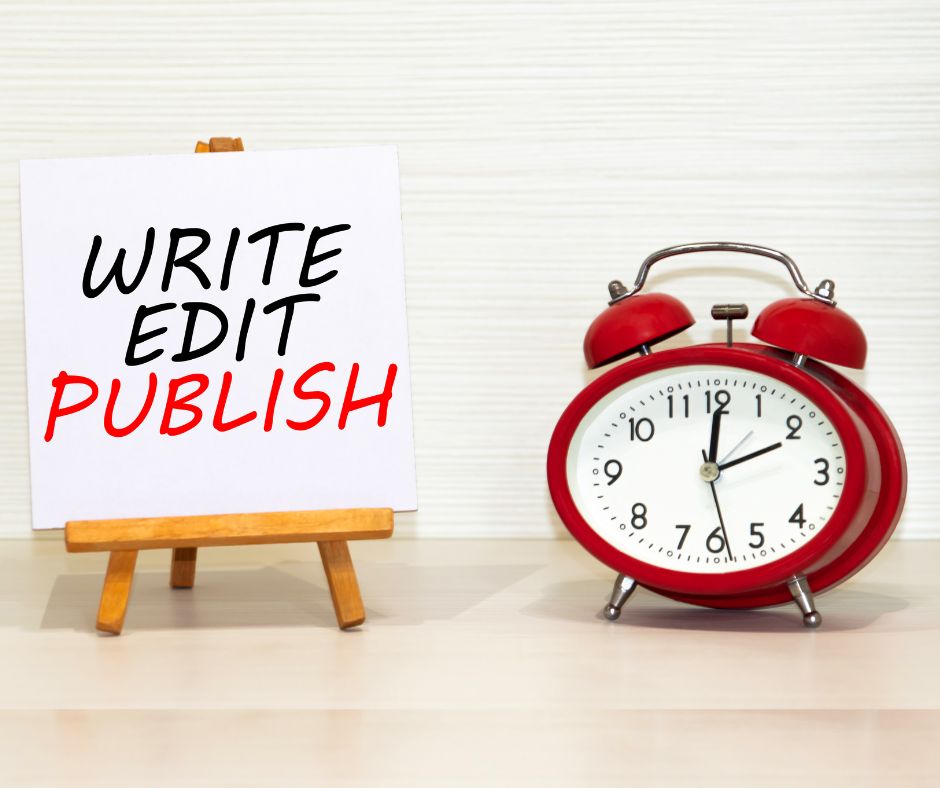Mastering Rapid Release for Romance Authors in 2025

I’ve been ghost writing since the end of 2019. I’m currently working on my 80th ghost written book (that’s 80 books in 60 months). That doesn’t include the 7 books I’ve written under my name during that same time (4 fiction, 3 nonfiction).
Granted, my “day job” is ghostwriting, so I have the time to write 1.3 books a month (Currently, I average one 70,000 book a month for my client). But other authors have found success in developing a consistent, rapid release strategy. As I look to 2025, I want to boost my own release schedule to more than 1 fiction book a year.
If you’d like to increase your romance release schedule, check out the tips below:
What is Rapid Release?
At its core, rapid release is all about publishing books back-to-back on a tight schedule—think monthly or even weekly! For romance authors, this approach has proven especially effective, as romance readers are among the most devoted and hungry readers out there. They can devour a book in a day or two, and once they’re hooked, they’ll eagerly wait for the next one… if it’s not too far behind!
The beauty of rapid release is that it keeps readers engaged in a series, heightening the anticipation and building buzz in a way that’s hard to achieve with a slower release schedule. Romance is particularly well-suited to this because readers love diving into worlds and characters they can get to know over several books. Think family sagas, best friend groups, or interconnected standalones. The faster readers can get to the next story, the more loyalty and excitement builds around your brand.
Note, this is the type of release that many clients who hire ghostwriters plan. Many of them have taken the Fiction Profits Academy or similar course (Ty Cohen has one too, I think) that teaches how to identify top selling books, how to hire a ghostwriter, how to hire editors and cover artists, how to set a publishing schedule, and how to market (using Facebook Ads and newsletter swaps), to build a successful publishing career.
Types of Rapid Release Schedules
You can do whatever you want in terms of setting a publishing schedule. Here are a few popular ones:
- Drop the first 2 books within a week, and the next books 2 to 3 weeks after.
- Publish every two weeks. This requires getting significantly ahead and an ability to write and process your books (edits, etc) quickly and efficiently. Or you can write shorter books (30,000 to 50,000 words)
- Monthly releases. For many, this still might be too much, but it’s definitely more realistic than every two weeks.
- Publish every-other month: This is six books a year. You can schedule them to hit peak romance topics such as Valentines day, Summer/Beach reads, spooky reads in the fall, and holiday in winter.
- Quarterly releases. Many indie authors settle on four-books a year. Depending on the series, it could be a series a year with four books in the series.
- Publish the entire series at once: Streaming TV has spoiled us when it comes to binging content. You can publish the entire series at once.
- Write a serial: You can release by chapters (episodes) to have a story that goes on and on and on. Once you have a “season” finished, you can publish as a book. You can publish your serial on Radish, Royal Road, Wattpatt, or on your own through platforms like Ream Stories or Patreon.
Planning Your Rapid Release Strategy
Success in rapid release requires:
1. Setting Realistic Goals
Burnout is a real thing for rapid release authors. Before diving into a rapid release schedule, it’s essential to set a pace that works for you. The key here is consistency: whether that means releasing a book every month, every two months, or even quarterly, the goal is to maintain a rhythm that keeps readers engaged without burning yourself out. A monthly release might maximize engagement, but if that pace feels overwhelming, a bi-monthly or quarterly release can still work wonders.
Rapid release authors generally get ahead in their schedules. When book 1 releases, book 2 is going up for presale, book 3 is with the editor, and book 4’s draft is nearly finished. Take a moment to assess how many books you need to complete ahead of time to stay on schedule comfortably. A good rule of thumb for rapid release is to have at least two or three books ready before you publish the first. This way, you won’t feel rushed between releases, and you’ll have the flexibility to tackle any last-minute edits or marketing needs without sacrificing quality.
2. Choose Your Series Type
The structure of your series can make a big difference in how easily you can plan and write for rapid release. Romance readers love getting attached to characters and seeing how their stories intertwine, so consider series options that deliver this experience. For example:
- Interconnected Characters: Series featuring siblings, best friends, or coworkers let each book focus on a different character’s love story while keeping a familiar cast in the background. This approach allows readers to immerse themselves in a shared world, building attachment with each installment.
- Interconnected Standalones: Alternatively, you could create a series that isn’t linked by characters but by a common setting, theme, or trope (like a shared small town or a billionaire world). This option allows for creative flexibility while maintaining a familiar vibe that readers will recognize and anticipate.
Whichever type you choose, keep reader expectations in mind. Romance readers tend to appreciate series that offer a mix of familiar elements and fresh surprises. Creating a structure that aligns with popular expectations while weaving in your unique touch can help keep readers hooked.
3. Understand Reader Demand and Trends for 2025
Romance is a genre that thrives on trends, and tapping into popular tropes can give your rapid release a significant boost. In 2024, fake relationships, dark romance (e.g. mafia), enemies to lover, and hockey romances have been popular. But that could change at any time, so you’ll want to research the top-selling romance books or follow popular romance influencers on social media to keep a pulse on emerging themes.
You can also leverage your reader community to gain insights into what they’re currently loving. A quick survey sent to your email list or a poll on social media can provide valuable feedback on the tropes and settings your readers are most excited about. This kind of direct input can guide you toward creating stories that have a built-in audience, helping your rapid release find traction right from the start.
Writing and Production for Rapid Release
When setting up your rapid release, you can afford writer’s block or other delays, especially if you plan to put your book up for pre-sale. Here are tips for getting all your ducks in order.
1. Pre-Writing and Drafting Strategies
Planning is your best friend when it comes to rapid release. For a series, take time to outline the overarching story arcs and character developments in advance. This can help you stay on track and maintain continuity across multiple books, which is essential when writing fast. If you’re dealing with interconnected characters or a storyline that spans several books, mapping out these arcs ahead of time will make your drafting process smoother and help you avoid plot inconsistencies.
Consider using tools like Scrivener or NovelCrafter to organize your story structure, keep track of character details, and maintain consistency from one book to the next. These tools can help you keep all your notes, world-building, and plot points in one place, making it easier to pick up where you left off with each new book.
2. Use a calendar!
There are many moving parts to writing, editing, and publishing a single book. In rapid release, you’re having to keep track of several books at once. Have a schedule in which you have every step of every book mapped out. For example, for book 1 you may have writing and order cover in February, revision first 2 weeks in March and editing last two weeks of March, presale and pre-launch set up in April, and release in May. Book two may be writing and book cover over in March (while revision and editing are happening with book 1), revision and editing in April, presale and launch in May, and release in June.
The point is, you may be focused on the current book, but you can’t forget the tasks required for the later books to insure they’re released on time.
3. Batch Your Production Steps
To maximize efficiency, try batching your writing and production steps. For example, you could draft multiple books before moving on to the editing phase, allowing you to maintain a consistent rhythm without constantly switching between writing and revising. This approach can also apply to editing, cover design, and formatting. Working on these tasks in bulk will help streamline your process and keep everything on schedule.
Another strategy is to alternate tasks, such as editing one book while drafting another. This method can keep your mind fresh by switching between tasks and ensures you always have something in the pipeline, helping to reduce any downtime between releases. Think of it as setting up a production line where each book is at a different stage, keeping the workflow consistent.
4. Engage with Cover Designers and Editors Early
Your editors and cover designers are crucial players in your rapid release strategy, so it’s important to book their services well in advance. With a series, you might consider pre-booking all your editing slots for the year and arranging a schedule that ensures each book moves smoothly through its stages. This not only avoids delays but also keeps everyone on the same page.
For a consistent brand, consider pre-ordering covers for the entire series. Working with your designer early on can help create a cohesive look and feel that readers will recognize from book to book. Having your covers ready in advance means you can focus on other aspects of the launch process without worrying about last-minute design issues, and it allows you to tease future books to your audience with covers that are already in hand.
Building Hype Pre-Launch
Marketing still plays a crucial role in success no matter how often you market. The advantage of rapid release is that once you gain a reader, it’s easier to keep them as you have a backlist and/or new books coming quickly to keep them engaged.
1. Create a Teaser Campaign
Building anticipation before your release is essential to get readers excited and talking about your series. Start with a teaser campaign that includes cover reveals, sneak peeks, and teaser quotes. Share these regularly on social media platforms, your website, and in your newsletters. For example, you could reveal one part of the cover each week or post a favorite line from the upcoming book with a hint about the storyline.
Platforms like TikTok, Instagram, and YouTube are perfect for engaging, visual content that can help build buzz. On TikTok, you could create short videos showing the “mood” of the series or host live cover reveals. On Instagram, consider sharing character aesthetics or story graphics, while YouTube can be ideal for longer sneak peeks or even reading an excerpt aloud. The goal is to create a sense of anticipation, giving readers something to look forward to with each post.
2. Use Pre-Orders Strategically
Setting up pre-orders for your series can help lock in readers early, especially those who are excited to stay with you for the whole journey. If possible, offer pre-orders for the entire series, beginning with book one, so readers can commit from the start. Platforms like Amazon allow you to schedule multiple books in a series for pre-order, which means that as readers finish one book, they can immediately pre-order the next, keeping momentum strong.
When it comes to distribution, consider whether Kindle Unlimited (KU) or wide distribution is the better fit for your audience. KU can be effective for binge readers, especially if you’re releasing quickly, as readers can go from book to book without additional costs. However, if you have a broader readership or want to reach a wider market, distributing to all retailers might better serve your goals. Some authors experiment with a mix, beginning with KU and then going wide, depending on their strategy.
3. Engage Your Existing Readers
Your current readers are often your best advocates, so make them feel special by giving them exclusive access. Consider creating an email series or a private group (on Facebook, Discord, or similar platforms) where you can share early sneak peeks, deleted scenes, or special updates about the series. You might even offer your inner circle a chance to vote on certain details (like a character’s name or favorite hobby) to make them feel even more invested.
Offering bonuses or exclusive content is another great way to drive pre-orders and sign-ups. You could create a bonus scene, downloadable artwork, or even an author Q&A video just for those who pre-order or join your list. This gives readers a reason to commit early, while the exclusive content adds value and strengthens their loyalty.
By building excitement with a strategic teaser campaign, making it easy for readers to pre-order the entire series, and nurturing your existing fan base, you’ll be setting your series up for a successful launch and sustained momentum.
Launch Day and Post-Launch Strategy
Your book is ready to release!
1. Make Launch Days Special
Launch day is the big moment, and making it feel special can drive excitement and engagement among readers. Consider hosting activities such as social media takeovers, live events, and giveaways. A Facebook or Instagram Live event where you discuss the book, answer questions, or do a quick reading can create a sense of connection and celebration. Social media takeovers, where you post on other accounts within your genre or niche, can help you reach new readers.
Giveaways are another great way to generate buzz. You could offer signed copies, exclusive swag, or a chance to win a gift card or another prize that resonates with your target audience. Make sure to promote these activities leading up to launch day to build excitement and ensure your audience knows where and when to join the fun.
2. Promotional Strategy for Each Book
Once your book is live, having a structured promotional plan in place can help sustain momentum. Invest in a mix of ads on platforms like Amazon, Facebook, and TikTok to reach different segments of your audience. For Amazon, consider targeting keywords or genres that align with your book’s themes. On Facebook, target readers interested in similar romance authors, and on TikTok, create short, engaging video ads that showcase the book’s vibe and hook potential readers with visual storytelling.
In addition to ads, set up newsletter swaps with other romance authors in your genre. These swaps allow you to reach a wider audience by promoting your book in other authors’ newsletters while they promote theirs in yours. You can use a service like Bookclicker, find newsletter swap groups on Facebook, and/or reach out to authors who target a similar reader as you do.
Consider participating in book promotion sites like BookBub, where you can list your book in a daily deal or feature, reaching romance fans who are eager to find their next read. For rapid release, aim to stagger these promotions so each book in the series gets its time to shine without overwhelming your marketing budget.
3. Rapid-Fire Ads and Reader Feedback Loops
Rapid release offers a unique advantage: you can quickly incorporate reader feedback and sales data to fine-tune your strategy for the next book. After each launch, monitor reviews, reader comments, and beta reader feedback to identify any recurring themes or suggestions. For example, if readers love a particular side character, you could plan to feature them more prominently in a later book, or if they’re looking for more of a certain trope, you can adapt upcoming stories to meet that demand.
Using rapid-fire ads is another powerful approach. Running short-term, targeted ad campaigns right after launch can give you immediate feedback on which visuals, ad copy, and targeting options resonate best with your audience. By analyzing this data, you can make informed adjustments to your ads for the next book in the series, maximizing effectiveness and getting better results with each release.
Tracking Success and Adjusting Your Strategy
If you’re going to do all the work to make rapid release a success, you need to know if it’s actually working.
1. Monitor Key Metrics
With rapid release, keeping a close eye on your performance metrics can make all the difference in maximizing your series’ potential. Start by tracking pre-orders and sales rank for each book. Pre-orders can give you an early glimpse into reader interest, helping you gauge how much hype you’ve built before each launch.
Meanwhile, sales rank—especially in Amazon’s category rankings—provides a sense of how well each book is performing against other books in the same genre.
Don’t forget to pay attention to review trends as well. Readers’ reviews often contain valuable feedback about what they enjoyed and what could be improved.
Additionally, use analytics to measure your ad performance across platforms like Amazon, Facebook, and TikTok. Take note of which ads are getting the most clicks and conversions, as well as any patterns in reader engagement on social media. By keeping a consistent watch on these metrics, you’ll have a clear picture of what’s working and where there’s room for improvement.
Finally, with rapid release, you’re hoping for more than a single book’s purchase; you’re looking for read-through. You want readers to go from book 1 to book 2 and so on. You want to track sales across the books. If book 2 has low sales, you want to consider whether it’s because it didn’t resonate with readers enough to have them wanting to read more.
2. Adapt to Market Feedback
Rapid release offers a unique advantage in that you can adjust your strategy as you go. Be open to pivoting based on reader feedback and sales data. For instance, if a particular trope or storyline is resonating with readers, consider highlighting similar themes in your marketing or even shifting your story arcs in upcoming books. Likewise, if reviews mention a character that readers especially love, you might feature that character more prominently in future installments.
Consider adjusting your release schedule or promotional strategy based on what you see in the initial results. If a monthly schedule feels too fast and leaves you overwhelmed, moving to an every-six-weeks or every other month release could improve both your quality and your ability to engage with your readers.
Similarly, if certain promotional tactics or platforms are delivering higher engagement, double down on those to maximize your reach. Flexibility is key in a rapid release strategy, and small adjustments can make a big difference in sustaining momentum.






Responses